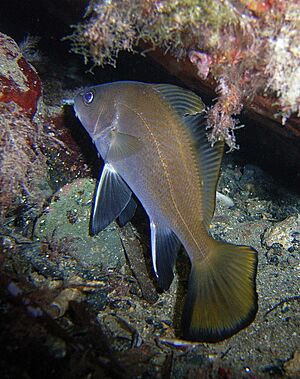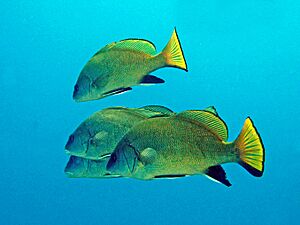Brown meagre facts for kids
Quick facts for kids Brown meagre |
|
|---|---|
 |
|
| Conservation status | |
| Scientific classification | |
| Synonyms | |
The brown meagre or corb (Sciaena umbra) is a type of ray-finned fish that lives in the ocean. It belongs to a group of fish called Sciaenidae, also known as drums and croakers, because some of them can make drumming or croaking sounds!
You can find the brown meagre in the eastern Atlantic Ocean, the Mediterranean Sea, and the Black Sea. They usually live in shallow waters, often near sandy areas or rocky spots. People sometimes catch them for food, especially in the Mediterranean region.
About the Brown Meagre
What does "Sciaena umbra" mean?
The scientific name for this fish, umbra, comes from a Latin word meaning "shadow" or "phantom." The first part, Sciaena, comes from a Greek word for a fish. So, its name might hint at its shadowy color or how it hides.
Where do Brown Meagres live?
Brown meagres are found in the eastern part of the Atlantic Ocean, stretching from the southern English Channel all the way down to Senegal and the Cape Verde islands. They also live throughout the Mediterranean Sea, the Black Sea, and the Sea of Azov. In the Mediterranean, they are considered a vulnerable species, meaning their numbers are decreasing.
What kind of places do they like?
These fish prefer depths between 5 and 200 meters (about 16 to 650 feet). They mostly hang out near rocky areas or sandy seabeds. Younger brown meagres can even be found in estuaries, which are places where rivers meet the sea.
How big do they get?
Brown meagres are usually about 30 to 40 centimeters (12 to 16 inches) long, but some can grow up to 60 centimeters (about 2 feet)! They have a unique shape with a flat belly and a strongly arched back. Their bodies are a bit flattened from side to side, and they have a large mouth that reaches their eyes.
Their fins are quite striking: the fins on their belly and near their tail are black with a white edge. The fins on their back and their main tail fin are yellow with a black border. Their bodies are generally grey, but they can have cool flashes of gold and silver!
Brown Meagre Behavior
Are they day or night fish?
The brown meagre is mostly a night-time fish. This means they are more active after the sun goes down. During the day, you might find them hiding among beds of seagrass or in rocky areas, often near caves or large cracks where they can feel safe.
Do they live alone or in groups?
These fish are social creatures and usually live in small groups. They like to stick together!
What do they eat?
Brown meagres are hunters. They feed on small fish and crustaceans, like crabs and shrimp.
How do they communicate?
One of the most interesting things about brown meagres is that they can make sounds! They use special muscles under their swim bladder (a gas-filled organ that helps fish float) to create these sounds. This is how they talk to each other, as they have excellent hearing. They can also control their buoyancy (their ability to float or sink) perfectly.
When do they have babies?
In the Mediterranean Sea, brown meagres usually lay their eggs and reproduce between March and August.
Protecting the Brown Meagre
Brown meagres are a popular fish to catch in the Mediterranean. They are caught using methods like spear fishing, trammel nets, and gill nets. Unfortunately, they can be easily caught when they gather in groups to lay their eggs, which can lead to too many being caught.
In some places, like Turkey, there were bans on catching these fish for sport and for selling them until 2003 and 2006. These bans helped to protect the fish and allow their populations to recover. It's important to manage fishing carefully to make sure there are enough brown meagres for the future.



